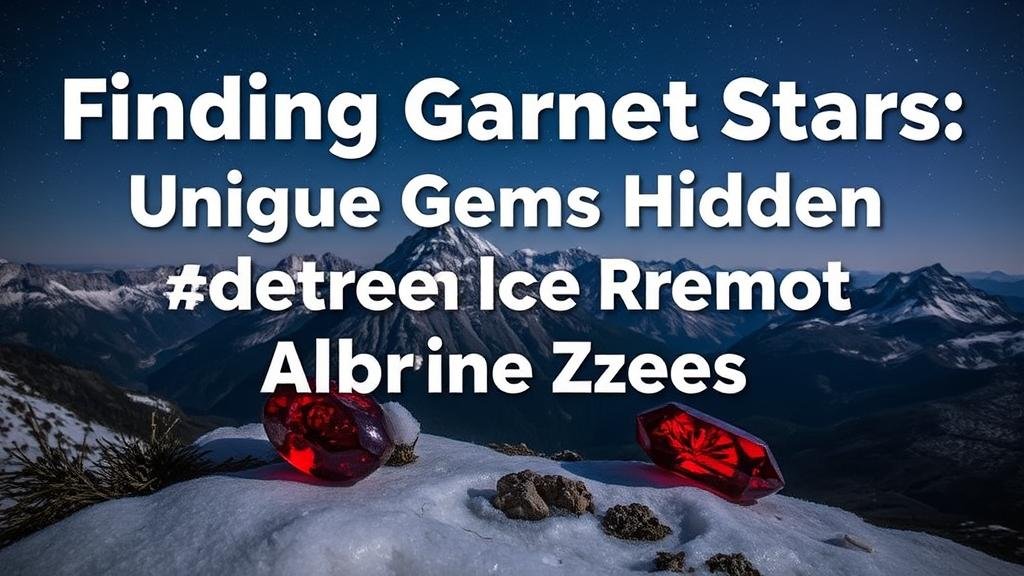Finding Garnet Stars: Unique Gems Hidden in Remote Alpine Zones
Finding Garnet Stars: Unique Gems Hidden in Remote Alpine Zones
The allure of garnet stars lies not only in their stunning appearance but also in the thrill of discovery associated with rockhounding in remote alpine regions. These unique gems, known for their striking star-shaped inclusions, are a prized find for mineral collectors and enthusiasts alike. In this article, we delve into the geology, characteristics, and practical tips for locating garnet stars in their natural habitats.
The Geological Background of Garnet Stars
Garnet stars, classified under the garnet family of minerals, possess a distinctive radial pattern often referred to as asterism. This optical phenomenon results from the reflection of light on needle-like inclusions, typically composed of rutile. Garnets themselves are silicate minerals that come in various compositions, with pyrope and almandine being the most common types associated with asterism.
Geologically, garnet stars are often found in metamorphic rocks, particularly schists and gneisses, which form under high temperature and pressure conditions. The presence of garnets in alpine regions can be traced back to ancient tectonic processes when continental plates collided, exposing these minerals to erosion.
Characteristics of Garnet Stars
The most captivating feature of garnet stars is their star-shaped inclusions, which typically have a four- or six-rayed appearance. following characteristics help in identifying these unique minerals:
- Color: Garnet stars can exhibit colors ranging from deep red to vibrant orange and even green, depending on their specific composition.
- Hardness: With a Mohs hardness rating between 6.5 and 7.5, garnets are durable and suitable for jewelry.
- Transparency: These gems can be transparent to translucent, affecting their overall visual appeal.
Understanding these characteristics is crucial for rockhounds when hunting for garnet stars as this knowledge enhances their ability to discern genuine specimens from other minerals.
Practical Tips for Collectors
Identifying Potential Locations
Finding garnet stars requires an understanding of geological formations and potential mining locations. Here are several notable regions known for garnet star occurrences:
- The Himalayas: Rich in metamorphic rocks, the Himalayas offer a high potential for garnet star finds, especially around areas where sedimentary rock layers have been uplifted.
- The Rocky Mountains: Specific regions in Colorado and Montana are known for garnet deposits, including varieties with star-like inclusions.
- The Alps: Alpine areas, particularly in Switzerland and Italy, host numerous garnet-rich deposits.
When choosing locations, consider factors such as accessibility, weather conditions, and regulations regarding mineral collecting.
Essential Equipment
Before embarking on a rockhounding expedition, ensure you have the proper tools to maximize your prospecting efficiency:
- Rock hammer: To break and test the rock.
- Safety goggles: To protect your eyes while prospecting.
- Field guide: To help identify garnet and other mineral specimens.
- Mesh bags or containers: For safely storing collected specimens.
Real-World Applications and Collecting Strategies
Beyond their aesthetic appeal, garnet stars hold value in various markets, from jewelry crafting to industrial applications. For example, garnets are used as abrasives due to their hardness and durability. Collectors can also benefit from understanding the current market trends, which can influence their buying and selling strategies.
When collecting garnet stars, remember to:
- Practice responsible collecting by adhering to local laws and regulations.
- Document your finds with photographs and notes to enhance their provenance and value.
- Network with local rockhounding communities for shared knowledge and potential collection sites.
Conclusion
Finding garnet stars can be a rewarding endeavor for rockhounds and mineral collectors. With the right knowledge, equipment, and strategy, you can uncover these captivating gems while enjoying the beauty of remote alpine landscapes. Equip yourself with geological knowledge and practical skills, and embark on your journey to treasure hunting–who knows what unique finds await you in the wild.


